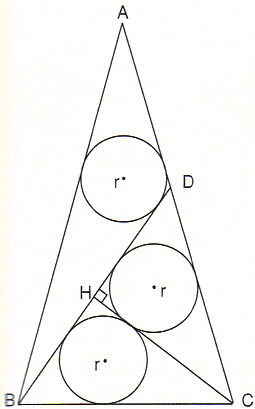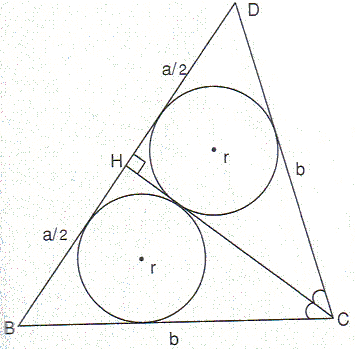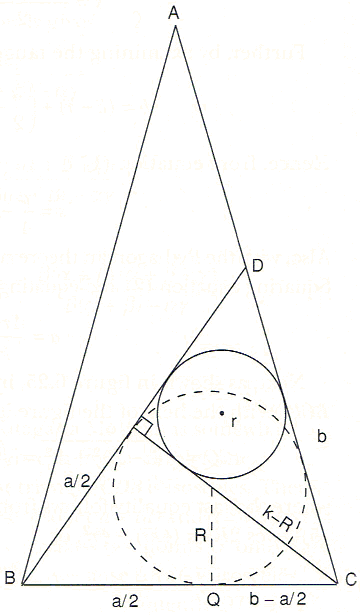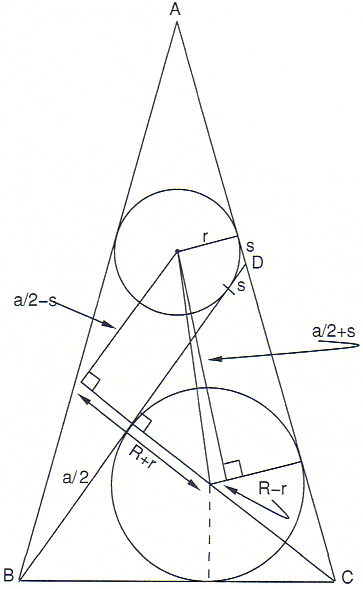A Restored Sangaku Problem
The sangaku discussed below was originally hung [Fukagawa and Rothman, pp. 194-195] in 1806 in the Atsuta shrine by Ehara Masanori, a disciple of Kusaka Makoto (1764-1833). The tablet, which contained only this problem and no solution, was subsequently lost. However, at an unknown date the mathematician Kitagawa Moko (1763-1839) visited the shrine and recorded the sangaku in his note "Kyuka Sankei," or "Nine Flowers Mathematics," along with his solution. More recently the shrine constructed a replica from Kitagawa's manuscript. Fukagawa and Rothman reproduce Kitagawa's solution with a warning: This may be the most involved exploitation of the Pythagorean theorem you have ever seen.

The problem is this: ΔABC is isosceles. Two lines BD and CH divide it into three smaller triangles, each of which circumscribes a circle of the same radius r. Find r in terms of CH.
Following [Fukagawa and Rothman, pp. 212-216], I shall give Kitagawa's solution and then, on a separate page, a solution by J. M. Unger.

First, notice from the figure above that triangle CDB is isosceles. Therefore let

T and T'' are equidistant from D and therefore
| (1) | s = (CD'' - CD) / 2 = (a - b) / 2. |
Further, by examining the tangents in the figure above, we see that
| (2) | b = (k - r) + (a/2 - r) = a/2 + k - 2r. |
Hence, from equation (1)
| (3) | s = a / 4 - (k - 2r) / 2. |
Also, with the Pythagorean theorem, from either ΔBCH or ΔCDH,
| (4) | a = 4r(k - r) / (k - 2r). |
Next, as shown below, inscribe a circle of radius R in triangle BCD.

With the help of the figure it is easy to show that
| (5) | CQ = √(k - R)² - R² = √k² - 2Rk = b - a/2 = k - 2r, |
where the last equality follows from equation (2). Squaring equation (5) gives
| (6) | R = 2r (k - r) / k. |
The strategy is now to eliminate R in favor of r and k. Applying the Pythagorean theorem directly to the figure below gives
(R + r)² + (a/2 - s)² = (R - r)² + (s + a/2)²,

or, after simplifying,
| (7) | 2Rr = as. |
The problem is almost solved. We now replace R on the left of equation (7) by equation (6) and as on the right by the expressions in equations (3) and (4) to get
4r²(k - r) / k = 4r(k - r)/(k - 2r) × [(r(k - r)/(k - 2r) - (k - 2r)/2],
which gives the cubic
k³ - 4rk² - 2kr² + 8r³ = (k² - 2r²)(k - 4r) = 0.
From any of the figures, the relevant root is
r = CH / 4.
References
- H. Fukagawa, A. Rothman, Sacred Mathematics: Japanese Temple Geometry, Princeton University Press, 2008
Sangaku
- Sangaku: Reflections on the Phenomenon
- Critique of My View and a Response
- 1 + 27 = 12 + 16 Sangaku
- 3-4-5 Triangle by a Kid
- 7 = 2 + 5 Sangaku
- A 49th Degree Challenge
- A Geometric Mean Sangaku
- A Hard but Important Sangaku
- A Restored Sangaku Problem
- A Sangaku: Two Unrelated Circles
- A Sangaku by a Teen
- A Sangaku Follow-Up on an Archimedes' Lemma
- A Sangaku with an Egyptian Attachment
- A Sangaku with Many Circles and Some
- A Sushi Morsel
- An Old Japanese Theorem
- Archimedes Twins in the Edo Period
- Arithmetic Mean Sangaku
- Bottema Shatters Japan's Seclusion
- Chain of Circles on a Chord
- Circles and Semicircles in Rectangle
- Circles in a Circular Segment
- Circles Lined on the Legs of a Right Triangle
- Equal Incircles Theorem
- Equilateral Triangle, Straight Line and Tangent Circles
- Equilateral Triangles and Incircles in a Square
- Five Incircles in a Square
- Four Hinged Squares
- Four Incircles in Equilateral Triangle
- Gion Shrine Problem
- Harmonic Mean Sangaku
- Heron's Problem
- In the Wasan Spirit
- Incenters in Cyclic Quadrilateral
- Japanese Art and Mathematics
- Malfatti's Problem
- Maximal Properties of the Pythagorean Relation
- Neuberg Sangaku
- Out of Pentagon Sangaku
- Peacock Tail Sangaku
- Pentagon Proportions Sangaku
- Proportions in Square
- Pythagoras and Vecten Break Japan's Isolation
- Radius of a Circle by Paper Folding
- Review of Sacred Mathematics
- Sangaku à la V. Thebault
- Sangaku and The Egyptian Triangle
- Sangaku in a Square
- Sangaku Iterations, Is it Wasan?
- Sangaku with 8 Circles
- Sangaku with Angle between a Tangent and a Chord
- Sangaku with Quadratic Optimization
- Sangaku with Three Mixtilinear Circles
- Sangaku with Versines
- Sangakus with a Mixtilinear Circle
- Sequences of Touching Circles
- Square and Circle in a Gothic Cupola
- Steiner's Sangaku
- Tangent Circles and an Isosceles Triangle
- The Squinting Eyes Theorem
- Three Incircles In a Right Triangle
- Three Squares and Two Ellipses
- Three Tangent Circles Sangaku
- Triangles, Squares and Areas from Temple Geometry
- Two Arbelos, Two Chains
- Two Circles in an Angle
- Two Sangaku with Equal Incircles
- Another Sangaku in Square
- Sangaku via Peru
- FJG Capitan's Sangaku
|Up| |Contact| |Front page| |Contents| |Geometry|
Copyright © 1996-2018 Alexander Bogomolny
73575170
